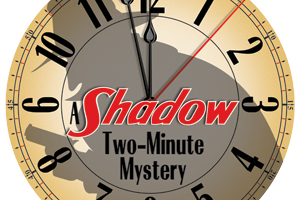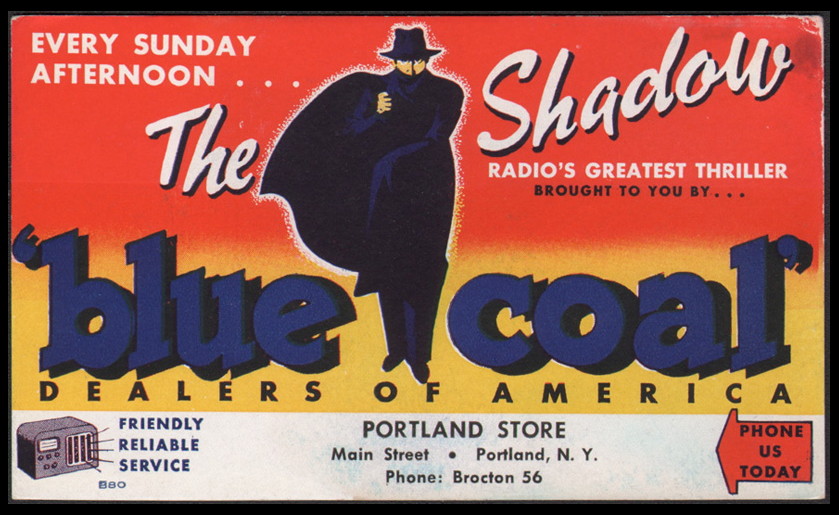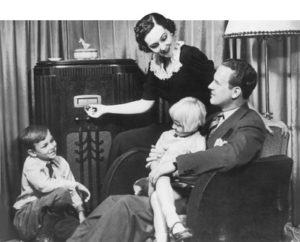
Can a human brain live inside the skull of a gorilla? The answer is yes, certainly, if you’re listening to an old time radio episode of The Shadow. That’s exactly what happened in the Sept. 16, 1945, episode titled “The Thoughts of Death.” I’m sorry to say that no recordings of this show have survived. You can’t hear it. But I can tell you about it. So read on.
Now, it appears that I spoiled the “big reveal” of the entire story, by telling you a man’s brain is transplanted into a gorilla head. But in actuality, knowing what’s happening in advance won’t spoil a bit of the fun of this wonderful classic adventure of The Shadow. So put yourself back on a Sunday afternoon in the fall of 1945. World War II was over… the unconditional surrender had been signed two weeks earlier. You were in the mood for some escapist thrills with The Shadow.
Elsie Thompson’s eerie organ music floats over the air, followed by the voice of radio actor Bret Morrison who speaks those words we’ve come to know so well… Who knows, what evil, lurks in the hearts of men? The Shadow knows! A bone-chilling laugh, some more organ music and announcer Don Hancock starts the opening commercial for Blue Coal.
He assures listeners that war veterans and war workers are returning to the mines and soon America’s coal industry will be operating at full strength again. Government war restrictions and limitations on the sale of solid fuel to homeowners have been cancelled. So order your supply of Blue Coal today! Boy, it’s a great feeling to know that the war is over and things are returning to normal, isn’t it? So, let’s return to The Shadow.

And it all started so innocently…
As our story opens, Lamont and Margo are dining in a quaint little restaurant facing the ocean. As they eat, Cranston feels something strange coming on. He seems to be getting a message… in his head! Someone is communicating with him by telepathy. He recognizes the message: A friend’s concern must always burn, for time congeals the love one feels. Where had he heard that before? It comes to him… Tony Ruskin! Tony was a young scientific genius they had known five years earlier.
Cranston is convinced that the telepathic message is from Tony Ruskin. Naturally they must track him down to find out what this is all about. It seems he is still in college… a graduate student, I suppose. They find him in his dorm room with his Uncle Philip, old Professor George and his sweetheart Susan Adams. Uncle Philip is a businessman who wants Tony to quite academia and join the family firm. Professor George thinks Tony should stay in college use his mind for the furthering of science. Susan tends to agree with the old professor. As for Tony himself, he’s getting a bit bored with school, and is considering quitting and going into the family business.
And what about the telepathic message? Just a lark, I guess. He was experimenting with mental telepathy and wanted to see if he could make it work. And it did.
Several days later, commencement exercises are over, and Tony has graduated. Susan calls Margo… she’s distraught. Tony has killed himself. Suicide. Blew his brains out with a shotgun. Margo and Lamont accompany Susan to the morgue. Yup, the body is undoubtedly Tony, even though his head is mostly blown away.
Message from the dead
That night, as Lamont Cranston sleeps, he keeps getting a mental message: Murder… murder… murder… It’s Tony calling to Cranston!
Aaaannnnd now it’s time for a commercial. Man, just when things were getting good. A dead man is communicating with Lamont Cranston via mental telepathy! We want to hear the rest. But instead, we have to sit through an agonizing 60 seconds of Don Hancock extolling the virtues of Blue Coal. To the valiant men in service who so gallantly bore arms in the defense of their country, Blue Coal is hiring them back. Five thousand men can be put to work immediately. Miners work for six days a week, with rate and a half for the sixth day. And annual vacation pay accrued at $75 per year. (I guess that was pretty good for 1945, if you could ignore the black-lung disease.)
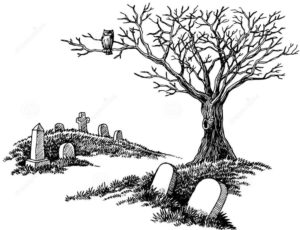
Okay, we’re back. Three days have expired and Lamont and Margo are at the cemetery paying their last respects to Tony Ruskin. Also there are Professor George, Uncle Philip and Susan. Tempers are on edge. Accusations fly. “You drove him to it!” “No, you did!” But Cranston’s still thinking about the other night when he heard Tony’s voice in his head.
On the drive home, Cranston hears the voice again. Murder. I was murdered. Help me to die. Lamont turns around and returns to the cemetery. But there, the telepathic voice is fainter. Hmmm… Maybe at the college? Yes! The mental impressions grow in strength as they approach the college library. Cranston and Margo follow the thoughts, which grow in intensity. They are taken to a small house beside the library. They break into the house and find…
Since I spoiled the climax for you, you already know what’s coming. They find a strange old laboratory. On the table, the head of a gorilla, with tubes running into the neck, connected to a pump carrying blood to the head. Pretty ghastly stuff for 1945!
The top of the head has been sawed off and replaced… and inside is a human brain. The brain of Tony Ruskin! Some madman has killed Tony but kept his brain alive. Who is that madman? Lamont and Margo hear someone coming. They hide.
The mad professor: cliché or classic?
It’s mad old Professor George. He comes in and has a long and bizarre soliloquy with the gorilla head. He promises Tony’s brain that he will give it the power of speech. Of course, the words will come from the mouth of the gorilla, but Tony won’t mind, he’s sure. So he blithely attaches a device to the gorilla’s throat. And behold… a voice!
It’s the voice of The Shadow, not Tony the Gorilla Head. But crazy old Professor George doesn’t know that. He thinks that it’s Tony who is talking. Strange that the gorilla lips don’t move… but no matter. He’s talking. So let’s have a conversation.
The Shadow interrogates Professor George, and the mad old academician thinks he is talking to Tony aka gorilla head.
“I’ve given you eternal life, and you can give it to me. We believed that the brain was the source of all life. Find a way to keep the brain alive and healthy, and we never die!”

Ah yes, the old lure of eternal life. But Tony was planning on leaving college to enter business… take his brain away and waste it… and Old Looney couldn’t have that. So the natural solution was to put his brain in a gorilla head. It all makes perfect sense, doesn’t it?
The Shadow, still playing the role of Tony Gorilla Head, begs to die. But Professor George won’t hear of it. How ungrateful! Given eternal life, Tony Gorilla Head seeks to be put out of his misery. But Professor George wants Tony Gorilla Head to use his intellect to figure out how to make the Professor eternal. But, without the gorilla head, I assume.
Tony, in reality The Shadow, refuses. You’ll never find eternal life through me. I won’t help you. Murderer! Well, Old Looney has heard enough of that, and in a pique of anger he rips the voice apparatus from the gorilla throat. But mysteriously, the gorilla head continues talking. Old Professor Looney Tunes still hasn’t figured out that it’s The Shadow doing the actual talking. He thinks Tony Gorilla Head is taunting him. And we can’t have that! No uppity gorilla head is going to talk back to me!
The mad professor is… mad
I’ll kill you! he shrieks. And he proceeds to smash the pump and the arteries and the brain. Smashes it to little itty-bitty pieces! And yet, the voice continues talking… taunting… laughing. Well if that’s not enough to send the professor completely over the edge, nothing is.
“No! No! You’re dead! You’re dead! I killed you! You’re dead! I killed you!”
And while the bonkers professor rants and raves in the background, The Shadow picks up the phone. “Hello, Operator. Give me the psychopathic ward.”
So as our story ends, Professor George is headed for a padded cell, Tony Ruskin has been put out of his misery, and Lamont and Margo drive home, Lamont’s arm around her. Come a little closer, darling. There’s a full moon in this man, and he wants — the aurora borealis.
I’m not sure I completely understand that last comment, but I get the feeling that there’s about to be a little smooching going on in that car. Lamont and Margo, just platonic friends? Maybe not!
For the final commercial, John Barclay, Blue Coal’s distinguished heating expert, reminds everyone that it’s not too early to start getting your furnace in shape for the winter. Check for air leaks, and if you find any, plug them with asbestos cement. Wait… what’s that, now? He’s promoting asbestos in your air system? Which you breathe? Whoa, how times change. Jump forward twenty years in time, and serious diseases like mesothelioma were definitely established as being caused by asbestos exposure. But remember, it’s 1945.
Don Hancock returns to remind everyone that tonight’s Shadow story is based on a story copyrighted by Street and Smith Publications. Exactly what story was that, you might ask? Why, the story told in tonight’s script, of course. Yes, it’s a somewhat circular logic, but was necessitated by the fact that radio shows couldn’t be copyrighted, and Street and Smith wanted some protection for their character. Don’t worry about it… it’s a legal thing.
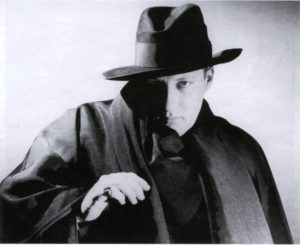
And here comes The Shadow one last time. The weed of crime bears bitter fruit… Crime does not pay… The Shadow knows!
Okay, you can flip off the radio now. The shows over. And a darned good one it was, too. They always put the “best” of the scripts at the beginning of the new radio season, so as to attract new listeners for the year. They wanted to start off the season with a bang. And that may explain why this terrific Shadow story was aired as the second episode of the 1945-46 season.
One of the things that made this episode of The Shadow special was that nothing in the story was faked, and then later explained away. That wasn’t always the case. In The Shadow’s radio adventures, he might encounter a ghost, which at story’s end was explained as a guy wearing a sheet. Mountain trolls would turn out to be circus dwarfs. An alleged vampire would actually be a guy with a syringe. Most of the time, those things that went bump in the night turned out to have perfectly normal explanations. Not so with this story, though. There actually was telepathic communication between Lamont Cranston, and a man’s brain was trapped in a gorilla’s skull. Yes, sometimes the boogey man was real!
Lamont Cranston, and his alter ego The Shadow, had the ability to communicate telepathically in various episodes of the radio show. It wasn’t mentioned often, but it was an established power of The Shadow as early as the 1938-39 Orson Welles season. He demonstrated the ability in “Message from the Hills,” “Terror Island,” and “Power of the Mind.”
The man behind the story
The scriptwriter for this episode was Stedman Coles. Coles was a regular writer for The Shadow; he wrote 17 Shadow radio scripts between 1944 and 1952. Only two audio recordings of Coles’ work on The Shadow have survived: his April 28, 1946, story, “Dreams of Death”; and the May 19, 1946, episode, “The Touch of Death.” One of his 1945 Shadow scripts, “The Shadow in Danger,” was adapted for Shadow Comics in 1948.
Stedman Coles also wrote scripts for The Crime Club, Roger Kilgore, Public Defender and Mr. Keen, Tracer of Lost Persons. He worked on radio into the mid-1950s, and did some television work as well.
So, there you have it. Another great exploit of The Shadow on the radio. It’s a “lost” adventure of The Shadow. No recordings seem to have survived. Sad. Because this was a classic, pulpy episode of The Shadow, in its truest sense. That’s pulp!

